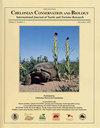两种南美淡水龟的日常和季节性日光浴行为
IF 0.8
4区 生物学
Q3 ZOOLOGY
引用次数: 4
摘要
摘要许多种类的爬行动物通过选择不同温度的微栖息地,即使在环境温度变化很大的情况下,也能将体温维持在较窄的范围内。淡水龟的体温调节通常是通过空中晒太阳来实现的,尽管它们在水中进行所有其他重要活动,如食物消耗和繁殖。因此,与晒太阳相关的时间预算应该受到限制,个人应该在晒太阳期间最大限度地提高单位时间的能量,可能是在寒冷的月份增加中午的晒太阳频率,并在水温下降时增加晒太阳的次数。我们分析了南半球夏季的晒太阳行为,以研究季节、水温和一天中的时间对2只南美洲淡水龟的影响:Trachemys dorbigni(黑腹滑龟)和Phryops hilarii(Hilaire的侧颈龟)。我们发现,水温对两个物种的晒太阳频率有不同的负面影响;T.dorbigni在昼夜周期内晒太阳,P.hilarii在季节水平上晒太阳。这两个物种在白天都表现出钟形的晒太阳频率,中午晒太阳的个体比上午和下午多。然而,只有肺门参对晒太阳表现出显著的季节性影响,夏季晒太阳的次数减少。这些结果表明,在2种澳大利亚海龟中,晒太阳行为的温度调节作用及其与其他重要活动的权衡。本文章由计算机程序翻译,如有差异,请以英文原文为准。
Daily and Seasonal Basking Behavior in Two South American Freshwater Turtles, Trachemys dorbigni and Phrynops hilarii
Abstract Many species of reptiles maintain their body temperature behaviorally in a narrow range, even in the presence of considerable environmental temperature variation, by choosing microhabitats with different temperatures. In freshwater turtles, thermoregulation is generally achieved by aerial basking, even though they perform all other vital activities such as food consumption and reproduction in the water. Therefore, time budgets related to basking should be constrained and individuals should maximize the energy per unit time during basking, potentially by increasing basking frequency at noon during colder months and increasing use of basking when water temperature decreases. We analyzed basking behavior during the austral summer to study the effects of season, water temperature, and time of day in 2 South American freshwater turtles: Trachemys dorbigni (black-bellied slider) and Phrynops hilarii (Hilaire's side-necked turtle). We found that water temperature negatively affected basking frequency in both species differently; basking by T. dorbigni occurred on a diel cycle while basking by P. hilarii occurred on a seasonal level. Both species showed a bell-shaped basking frequency during the day, with more individuals basking at noon than in the morning and afternoon. However, only P. hilarii showed a significant seasonal effect on basking, with basking frequency decreasing in summer. These results suggest the thermoregulatory role of basking behavior in 2 austral turtle species and its trade-off with other vital activities.
求助全文
通过发布文献求助,成功后即可免费获取论文全文。
去求助
来源期刊
CiteScore
1.70
自引率
14.30%
发文量
17
审稿时长
>12 weeks
期刊介绍:
Chelonian Conservation and Biology is a biannual peer-reviewed journal of cosmopolitan and broad-based coverage of all aspects of conservation and biology of all chelonians, including freshwater turtles, marine turtles, and tortoises. Manuscripts may cover any aspects of turtle and tortoise research, with a preference for conservation or biology. Manuscripts dealing with conservation biology, systematic relationships, chelonian diversity, geographic distribution, natural history, ecology, reproduction, morphology and natural variation, population status, husbandry, community conservation initiatives, and human exploitation or conservation management issues are of special interest.

 求助内容:
求助内容: 应助结果提醒方式:
应助结果提醒方式:


